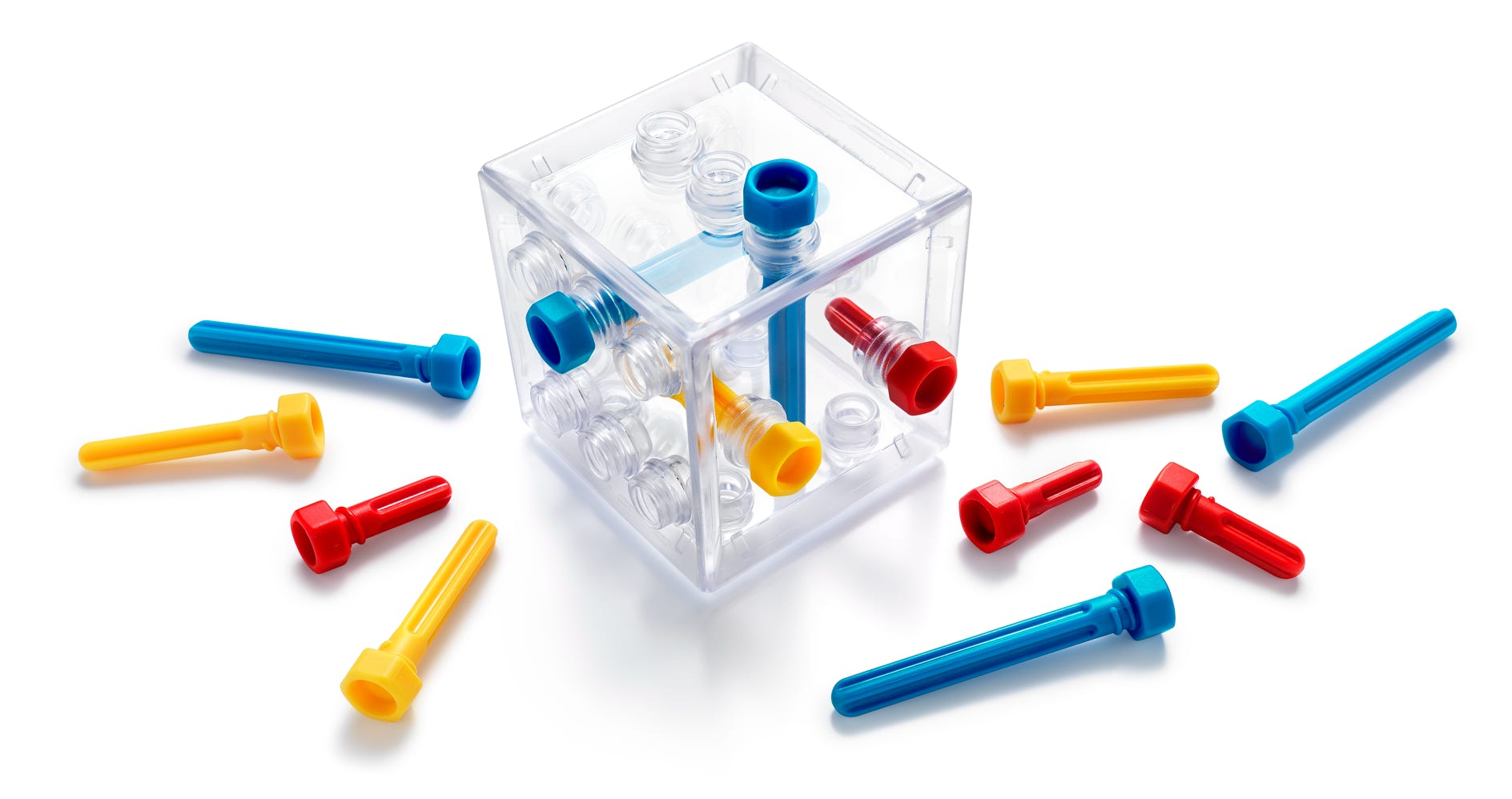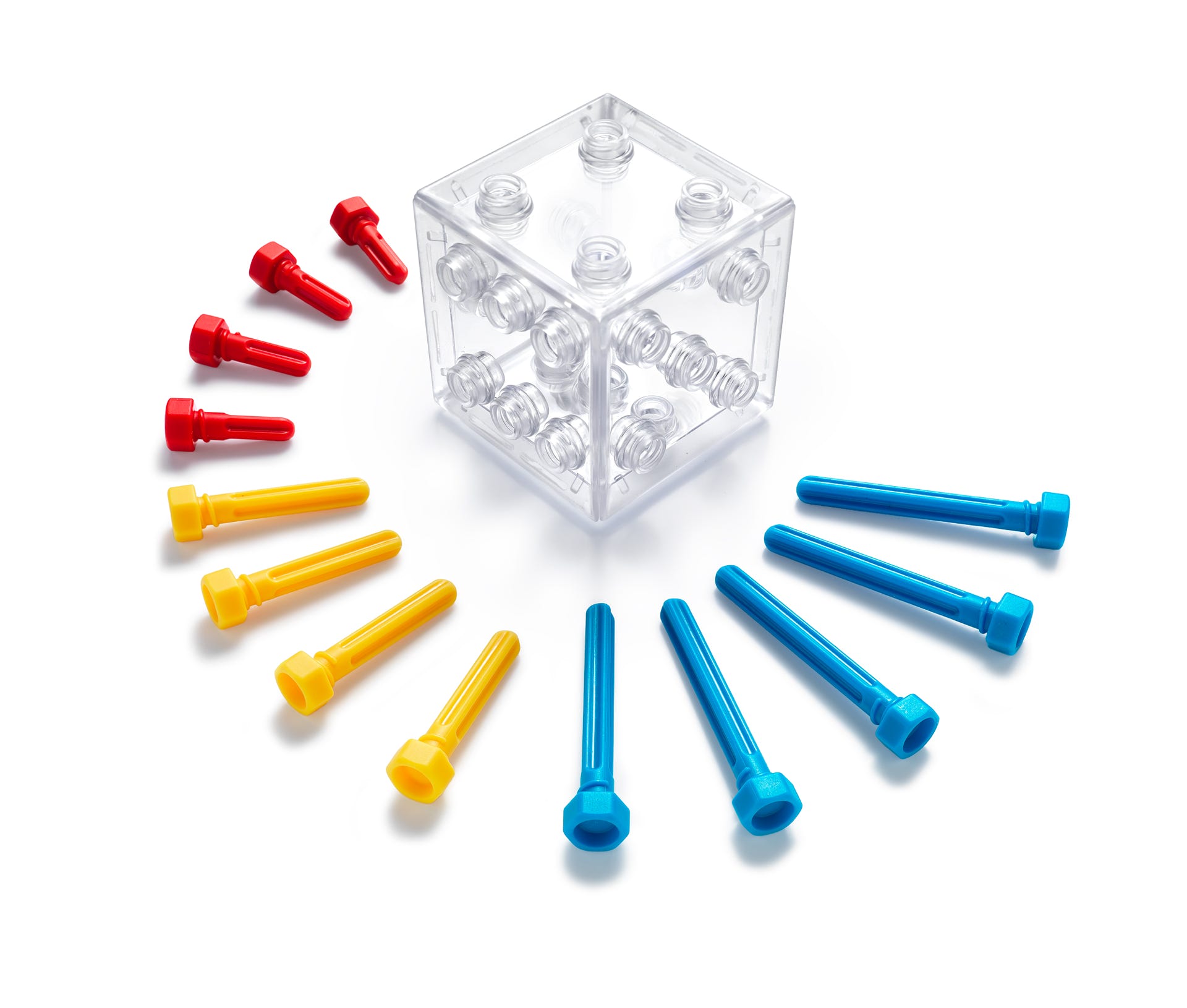
Criss Cross Cube

The product development of Criss Cross Cube (for SmartGames)
Raf Peeters, January 2023
For many years I wanted to do design an IQ-Puzzle that poses a real 3D challenge. I have already created a few puzzles based on cubes, such as the Cube Puzzlers and ZigZag Puzzle, but in those games, you always start from a base and build your way up. I wanted to create a 3D puzzle that required constant rotation during the solving process, and that didn’t have a specific starting position.
CHALLENGES WITH A TWIST
I had a very clear idea of what I wanted to achieve, but a good idea doesn’t necessarily translated in a product that can be realized. Fortunately in this case it worked. My colleague Alain wrote a program to calculate all possible challenges and solutions and some puzzle sets were promising enough to move forward with this project.
The size of the cube was easily defined, as we wanted the final product to be in the same category as the Cube Puzzler Pro and Cube Puzzler Go. Therefor the transparent cube has the same outer dimensions, but this time all sides of the cube are permanently fixed together. You can’t open or close it as you can with the two other Cube Puzzlers. It’s also not needed to store the pieces because in this case you don’t have standard puzzle pieces but bolts of different lengths. You start with some bolts in specific positions as shown in the challenge and need to find a place for all other bolts. There is only one solution for each challenge. Holes that are shown empty in the challenge need to stay empty in the solution.
The position of the holes is not randomly chosen. The holes are positioned on the cube just like the spots on dice, although this game has nothing to do with real dice. For those who don’t know, on six-sided dice, the sum of the dots on opposing sides adds up to seven. The reason for placing the holes in this configuration is that it makes it easier for customers to navigate the cube, because every side has a clear “personality”. If all sides had holes in random places, it would be much harder to find that specific side of the cube you needed, for example for your setup or to check the solution. Now you have a distinctive side with 1, 2, 3, etc holes. What is also nice about the position of the spots on a dice is that this equally distributes the holes over the surface of the cube. The side with 1 hole has an opposing side with 6 holes. If you use the longest bolt, you can always access most of the positions inside the cube from one end or the other. But the orientation of the holes on some sides are different from how they are placed on a dice, because it resulted in more interesting challenges to do so. For example the 3 holes are not placed diagonally, as they normally would be on a dice.
Originally I wanted to make the bolts from a flexible material like TPR. Bolts would be kept in place by friction. But it’s hard to test this with a prototype, so we also tried a version that you had to screw like a real bolt. And that worked so flawless that we kept that design. If you are afraid that this leads to endless screwing and unscrewing of bolts, don’t worry. You only need to rotate a bolt about a quarter of a turn to fix it inside the cube. So this handling goes quick and effortlessly.
Most challenges show two adjacent sides of the cube. Only the hardest levels just show 1 side. To my surprise most challenges are perfectly deductible. If you look every time careful for the one space (of 27 spaces inside the cube) that can only be filled by a specific bolt, you can deduct the solution from start to finish. It feels a bit like a 3D Sudoko. Every time you deduct the placement of a specific bolt, you get new information that leads to the next. Only in the MASTER and WIZARD levels you need a bit of trial and error. The reason is that these challenges only show one face of the cube, but you don’t know which the correct starting orientation is. The side that shows 6 holes has two possible orientations. But the sides that show 4 or 5 holes have even 4 possible orientations. And only one orientation will lead to a solution. BTW, there are no challenges with a unique solution that show the side with 1, 2 or 3 holes. For who wants to know, there are 353 ways to fill up the cube, we tried to select the 80 challenges with the most variation. But you can always try to find all other packings if you want to try. Criss Cross Cube will become available in Summer 2023.

Example of a challenge and solution of Criss Cross Cube showing 2 adjacent sides in the challenge.

Example of a hard challenge and solution of Criss Cross Cube showing only 1 side in the challenge.

GAME RULES CRISS CROSS CUBE
BEFORE YOU START
Remove all of the bolts from the cube by unscrewing them. There are 13 bolts:
- 4 short (red)
- 4 medium (yellow)
- 5 long (blue)
1) Choose a challenge. Easier challenges show two adjacent sides of the cube. More difficult challenges only show one side. Screw the shown bolts into the cube as indicated.
2) Fit in ALL the remaining bolts:
A) Often bolts will block each other.
B) 8 holes will remain empty in each solution. Holes on the side(s) that are shown empty in the challenge (white circles), should remain empty in the solution!
3) You have solved the challenge when all the bolts are screwed completely inside the cube. There is only one solution, found at the end of the challenge booklet.
HINTS
Challenges that show only 1 side of the cube do not indicate a specific orientation of the cube. In these cases, players must note there are 2 or 4 different orientations possible as they set up the cube, and therefore also multiple starting positions for the bolts. Finding the correct orientation is part of the challenge, as only 1 starting position will result in a solution.
Website ©2023 Raf Peeters
Products and images: © Smart